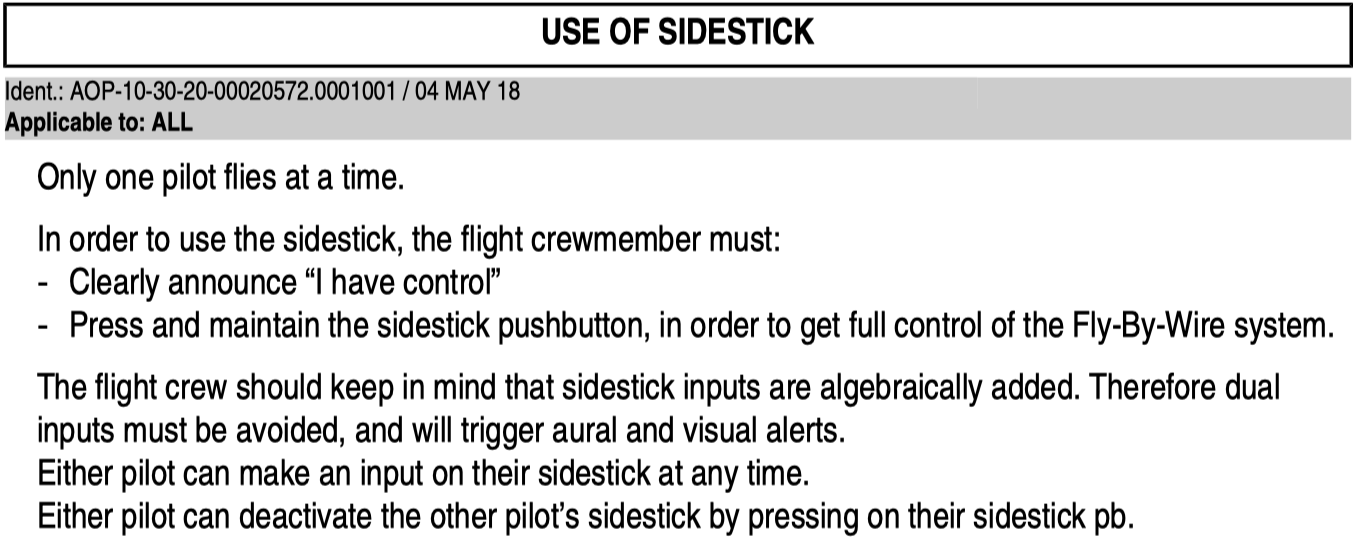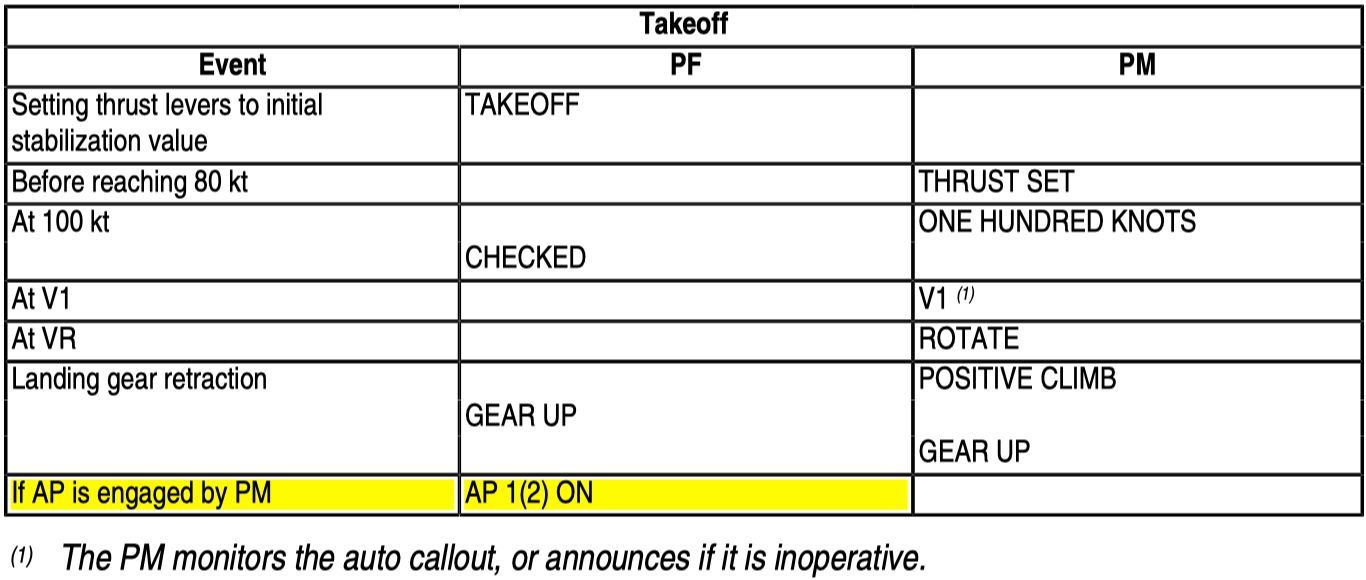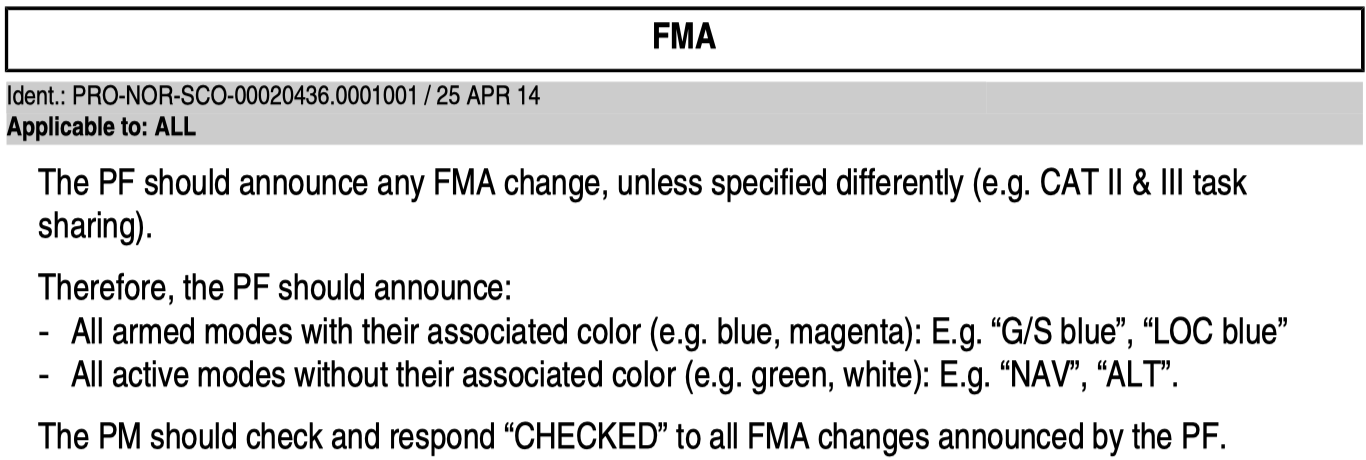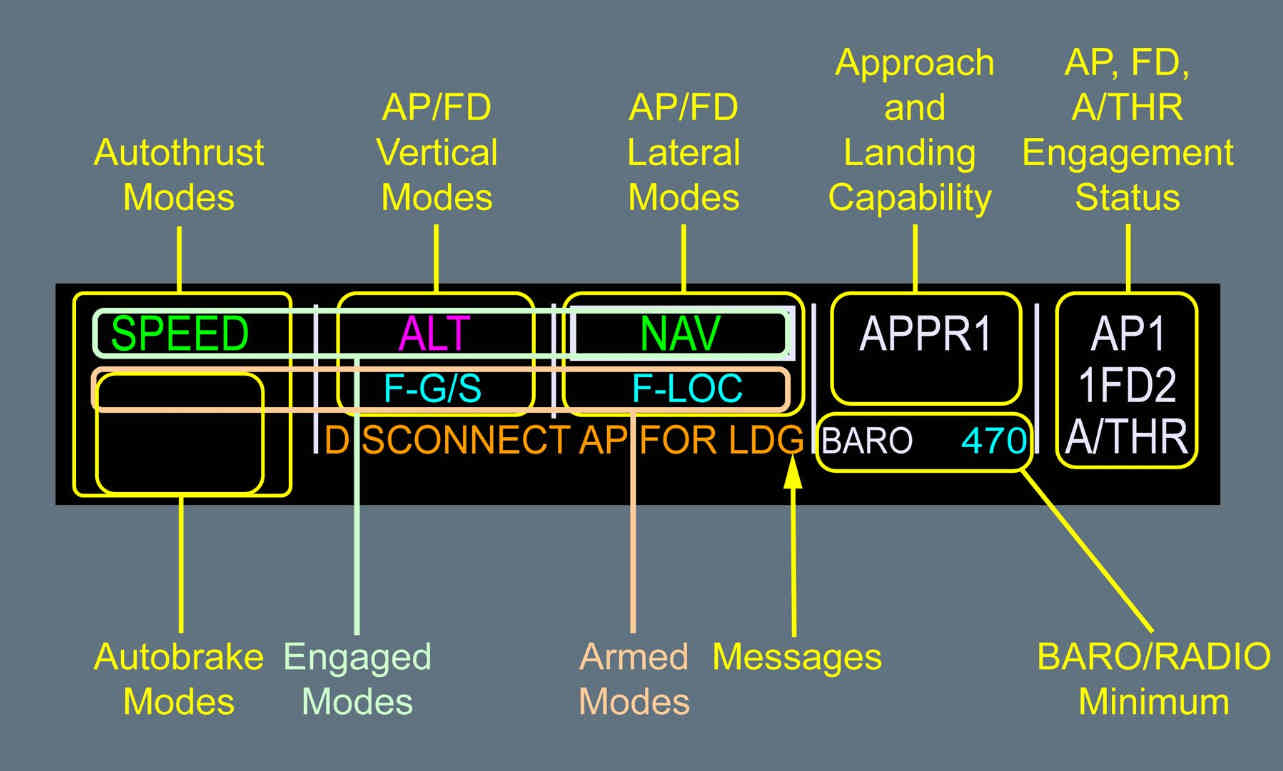在五边断开自驾的时候,有的人会喊话“I have control”,有的会喊“AP OFF”,也有人喊点儿别的。那么应该怎么喊呢?
1 关于“I have control”
在 FCTM AOP-10-30-20 A USE OF SIDESTICK 部分有这样的描述:
“In order to use the sidestick” 的确会让人觉得在使用侧杆前需要喊出“I have control”。然而,从整体上看,这部分讲的是如果要接管另一个人的侧杆,需要喊话,并且按压接管按钮,以避免双输入。并不是指断开 AP 人工操作的问题。
另外,在 FCOM PRO-NOR-SCO H PF/PM DUTIES TRANSFER 中的描述中,提到的场景也是交操纵:
而五边断开 AP 的时候,既不存在交操纵,也不存在接管,所以不需要喊话 “I have control”。
空客在回复中确认了这一点。
2 关于 AP OFF
在 FCOM PRO-NOR-SCO C ACTIONS COMMANDED BY PF 中有相关描述:
需要注意的是,“ACTIONS COMMANDED BY PF” 意思是 PF 下令 PM 做动作时的喊话。比如 PF 在人工飞行,需要 PM 来设置 FCU 之类时用到的。而通常 AP 接通时, PF 自己操作这些是不需要喊的。
回到五边断开 AP 的情况,这是在 AP 接通时 PF 自己断开的,所以不存在下令的问题。也就不需要喊话“AP OFF”。
这一点,在 FCOM PRO-NOR-SCO I SUMMARY FOR EACH FLIGHT PHASE 也有印证:
可以看到,只有 PF 下令让 PM 接通 AP 时,才需要喊话“AP 1(2) ON”.
3 关于 FMA/PFD/ND 上的变化
在 FCOM PRO-NOR-SCO C ACTIONS COMMANDED BY PF 中提到,所有 AFS CP 和 FMS 的操作都需要在 PFD/ND 上确认。所以,不管是 PF 喊话下令 PM 操作了面板,还是 PF 自己操作了,都需要喊出 PFD/ND 上的变化。当然确切地讲,这里说的是“checked”,并不是喊话,所以如果说用手指这屏幕 check 算不算,我也只能说算哈哈。
比如,PF 要让 PM 来设置航向 090,需要喊话“PULL HDG 090”。PM 在操作后,需要喊出 FMA 的变化“HDG”以及 PFD/ND 上航向“090”。而如果是 PF 自己操作,只需要喊出 FMA 的变化“HDG”以及 PFD/ND 上航向“090”。
另外,在 FCOM PRO-NOR-SCO D FMA 中是这样描述的:
比如,不管是 PF 下令还是自己接通的 AP,接通后 FMA 右上角就会出现白色的 AP1 或者 AP2 字样。因为 FMA 变化了,就需要喊出“AP1”或者“AP2”。
但需要注意的是,空客在回复中确认,FMA 的变化特指模式的预位和激活,而不包括模式的消失。所以断开 AP 后不需要对 FMA 中 "AP1(2)" 的消失进行喊话。
4 关于机组之间的沟通
上面三部分确认了:
- 正常断开自驾人工飞行之前,不需要喊 “I have control”,也不需要喊 “AP OFF”
- AFS CP 和 FMS 的操作需要在 PFD/ND 上确认
- FMA 的变化指模式的预位和激活,不包括模式的消失
而在这些严格定义和描述之外,虽然空客没有也不可能制定事无巨细的标准喊话,但机组之间可以采取必要的沟通来增强情景意识。
Airbus does not specify a standard callout for before the action is completed, however it is considered that the action is communicated to ensure situational awareness of both crew members. Following the action to disconnect the autopilot, the FMA announcement should be made.
所以总的来说,在断开自驾之前, “I have control” 和 “AP OFF” 都不是强制的喊话。但也并不意味着 PF 只能在不告知 PM 的情况下直接断开,说一句“我断开了哈”或者“人工飞一会儿”之类的也是完全没有问题的。
原文:
Q1:
In FCTM AOP-10-30-20 A USE OF SIDESTICK, the description is as follow:
In order to use the sidestick, the flight crewmember must:
‐ Clearly announce “I have control”
‐ Press and maintain the sidestick pushbutton, in order to get full control of the Fly-By-Wire system.
It sounds like we should call out "I have control" before disconnect the AP to use the side stick in final approach.
However, the whole sector of "USE OF SIDESTICK" seems to state the sidestick priority logic and requirement. For that, "I have control" callout is just a reminder to another crew that now the priority is belong to me.
So need we call out this before disconnect the AP?
A1:
(注意,空客第一次回复中有错误,在第二次回复中修正了)
In accordance with FCOM-PRO-NOR-SOP-210 P 1/6 chapter, we confirm that PF needs to call out AP...OFF in case of manual landing.
Therefore, we confirm CSC that there is no need to call out "I have control" when flight crew disconnect the AP.
The referenced content relates to when a flight crew member wishes to take control and calls "I have control".
Q2:
In FCOM-PRO-NOR-SOP-210 P 1/6 chapter, AP...OFF is an action, not a callout.
And in PRO-NOR-SCO, there's no callout related to the AP OFF. Only in "ACTIONS COMMANDED BY PF" chapter, there's description:
The simple "ON" or "OFF" command is used for the autopilot, the flight director, the A/THR and the bird (flight path vector).
However, it is just used for PF's command, not for PF's action by himself.
So, does it mean there's no standard callout before AP OFF, and we can use our own word to notify another crew?
A2:
Further to your recent request regarding call out in case of AP disconnection for your A350 Aircraft, Airbus would like to provide the following comments for your information:
We would like to update our previous answer regarding AP disconnection during final approach.
In accordance with FCOM-PRO-NOR-SCO 00011907.0001001 that you refer in your question, we confirm that the simple ON or OFF command is used for the autopilot when actions are commanded by the PF.
Airbus does not specify a standard callout for before the action is completed, however it is considered that the action is communicated to ensure situational awareness of both crew members. Following the action to disconnect the autopilot, the FMA announcement should be made.
Indeed, the final words to be used can be developed by operators to suit their specific needs.
Q3:
Additional question.
In FCOM PRO-NOR-SCO D FMA, "the PF should announce any FMA change". Usually, we consider the change of armed and active modes. However, in the strict sense, the mode disappearing also should be regarded as mode change, such as AP1(2) to no display or A/THR to no display. So should we announce the mode disappearing, and how to announce?
A3:
As per Airbus policy, the callouts for FMA modes relate to any change displayed on FMA, but not disappearing modes.
Refer to FCOM PRO-NOR-SCO, it is specified that the PF should announce:
- All armed modes with their associated color
- All active modes without their associated color.
In order to help the PF for FMA change announcements, a white box appears for 10 s around the mode change (refer to FCOM DSC-22-FG-90-80 FMA).






